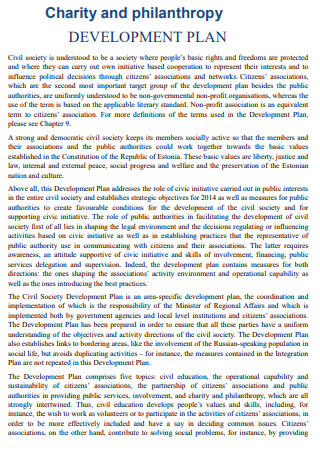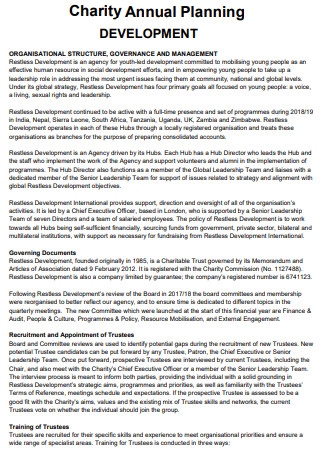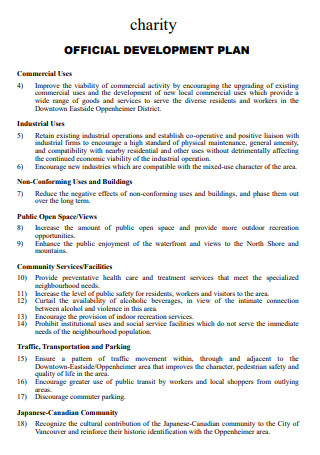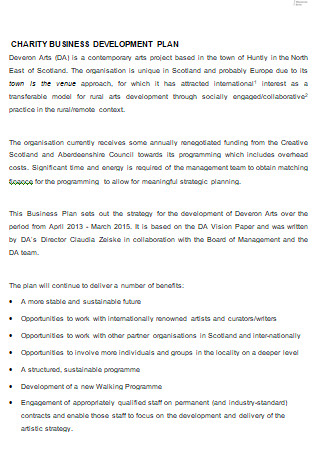4+ SAMPLE Charity Development Plan
FREE Charity Development Plan s to Download
4+ SAMPLE Charity Development Plan
What Is Charity Development Plan?
What Is Charity?
What Is the Importance of Charity Development Plan?
Different Types of Charities:
5 Reasons to Give to Charity:
How to Make a Charity Development Plan:
FAQs
What are the required skills of a charity development manager?
What is the importance of charity in our society?
How do I volunteer for a charity?
What Is Charity Development Plan?
Charity Development Plan is basic planning for a faith-based organization or a community services agency. The primary objective is to nurture relationships with current and potential corporate and individual donors and oversee fundraising activities. Moreover, charity development manager may execute administrative tasks in this position, such as entering donations received into a tracking system and sending documentation of gifts to donors. A major job responsibility for a charity development manager can be managing fund development activities. This can comprise everything from sending out donor invitations, managing volunteers, and ensuring all the logistics run smoothly for the event. They may also be responsible for sourcing and applying to grant funding opportunities. In addition, they could also be responsible for working with organizational management to create and implement strategies to promote the organization’s mission and attract new donors.
What Is Charity?
Charity’s goals have to fall into categories that the law says are charitable. These are things like stopping or relieving poverty, or advancing the arts, culture, heritage or science. It has to be established wholly for what is known as public benefit. That means its only purpose must be charitable. Charities cannot make profits. All the money they raise has to go towards achieving their target goals. Lastly, a charity cannot have shareholders or owners who benefit from it.
What Is the Importance of Charity Development Plan?
Charity is important and therefore meant to be done for public benefit, relief, and to give assistance to people at times of need in any part of the world, especially those who are the victims of natural disaster, war, catastrophe, hunger, disease, poverty, orphans by supplying them with food, shelter, medical aid, and other fundamental needs.
Different Types of Charities:
When understanding all the various ways to support the community and the world, it will require generosity and have that much larger of an impact. Learn more about the different types of charities that exist in the world:
Animal Charities
Animal charities are just what they sound like—a way to support, protect, and conserve animals and wildlife. Because of how comprehensive this charity is, it often breaks down into four distinct subcategories:
- Wildlife Conservation Organizations
- Zoos and Aquariums
- Hunting and Fishing Conservation Groups
- Pet and Animal Welfare Organizations
Now, reliant on which category interests you, you should do further research to find the charities that truly match up with what you want to support. If you want to conserve grasslands and the wildlife within them, then you will need to do your research to find charities that pursue that goal. It is never a good idea to indiscriminately support a charity—doing your research can ensure a good selection.
While animal charities help protect and conserve animals and wildlife, arts and culture charities preserve artistic and cultural heritage. This can manifest in a diversity of ways, from celebrating the arts to preserving the history of diverse art forms. Just like animal charities, there are subcategories for this type of charity:
- Museums and Art Galleries
- Public Broadcasting and Media
- Performing Arts
- Libraries and Historical Societies
It may not seem like these qualify as charities, but a lot of these organizations work and survive off some sort of donation. Without support from their communities, a lot of these charities would not be able to survive.
Community Development Charities
Think about your community. You know there are always things that could benefit from improvements or enhancements. You know there are areas and people who struggle more than others, for many reasons, and they are a part of the community as well. To keep your community vibrant and supported, there are non-profit organizations. They function to support and regenerate communities, especially those that are impoverished or struggling. Affordable housing projects are the most common example of these charities.
Education Charities
Education charities work and serve students from every age group—pre-school to graduate school and beyond. Since this is such a wide category, some of these charities serve as educational institutions, while others focus on making education more available and effective for different people and communities. Few common subcategories are:
- School Reform and Experimental Education
- Private Elementary, Junior High, and High Schools
- Scholarships and Financial Aid Services
- Different Support for Students, Teachers, and Parents
The land of education charities is a vast one, and there are so many avenues to support. Once more, do your research to find the scenario you most want to support. Whether it be inner-city students, first-generation college students, or school supplies for impoverished areas, there’s a charity that exists for you to support.
Environmental Charities
Environmental charities focus on preservation, appreciation, and sustainable development for the environment. This type of charity strive to preserve our planet in a myriad of ways. There are two primary subgroups when it comes to this kind of charity.
- Environmental Conservation and Protection
- Parks and Nature Centers
There is so much underneath these categories that helps establish these charities—from small organizations that work to plant more trees, to charities that seek to preserve the natural beauty around the world. There is always some type of environmental charity you can support that hardly takes any effort on your part.
Health Charities
There is a wide variety of organizations that fall under this category that you may not even realize that some of your favorite organizations are health charities or support other health. Here are a few of the common subgroups:
- Disease and Disorder Charities
- Patient and Family Support Charities
- Medical Research Charities
- Medical Services and Treatment
Health charities cover everything from supporting and treating people who are sick and disabled, working on cures for diseases, and even promote public awareness.
Human Services
Human services is another comprehensive charity category. It takes a lot of diverse life experiences into consideration and ends up being the “fallback” category for a lot of organizations because it is so general and all-encompassing. Normally, you will find the following groups underneath the human services charity category:
- Homeless Services
- Children’s and Family Services
- Social Services
- Food Banks, Food Pantries, and Food Distribution
- Multipurpose Human Service Organizations
- Youth Development, Shelter, and Crisis Services
Bear in mind that this is not an all-encompassing list of the different human services subgroups. Depending on the charity you decide to support, they could mark way more than what’s listed above.
5 Reasons to Give to Charity:
If this has stimulated you to make a donation to charity, start helping now. Make it easy by finding a charity that is working for causes important to you; whether you want to make a one-off donation, set up a donation plan or find out how to donate your time.
How to Make a Charity Development Plan:
Step 1: Data Collection
Before getting started with the writing collect financial, operating, and other relevant data. If your charity is already in operation, this should at the very least include financial statements detailing operating expense reports and a spreadsheet that indicates funding sources.
Step 2: Goal of the Matter
A charity development plan should start off with an articulation of the core values and your mission statement. Outline your vision, your guiding philosophy, and any other principles that provide the purpose behind the work. This will help you to polish and communicate your charity message clearly.
Step 3: Outline
An outline will help you understand what you need to tell your audience, whether it is in the right order, and whether the right amount of emphasis is placed on each topic.
Step 4: Products, Programs, and Services
In this section, you should provide more information on exactly what your charity organization does.
- How does your charity benefit the community?
- What products, programs, or services do you provide?
- What need does your charity meet and what are your plans for meeting that need?
Step 5: Marketing Plan
A marketing plan is vital for a charity to reach its goals. If your charity is already in operation, define in detail all current marketing activities: any outreach activities, campaigns, and other initiatives. Be particular about outcomes, activities, and costs.
Step 6: Operational Plan
An operational plan describes how your charity development plans to deliver activities. In the operational plan, it is important to detail how you plan to maintain your operations and how you will evaluate the impact of your programs.
Step 7: Financial Plan
This is one of the most important parts of your charity development plan. Creating a financial plan will allow you to make sure that your organization has its basic financial needs covered.
FAQs
What are the required skills of a charity development manager?
One of the important skills required in being a charity development manager is excellent communication skills. You will need to successfully represent your charitable organization and interact with donors. In addition, you should have strong attention to detail and organizational abilities for tasks like tracking project goals or event planning. You should also have effective technical skills in order to utilize donor database programs.
What is the importance of charity in our society?
Charity gives hope and inspiration to people. It improves and strengthen personal values and encourages people to be better. In addition, it improves the world community—which means giving as a noble gesture.
How do I volunteer for a charity?
Here are the steps you can take to volunteer in your community:
- Create a volunteer resume.
- Decide which causes you care about.
- Identify the skills and knowledge you can offer.
- Determine how often you can volunteer.
- Research volunteer opportunities in your community.
- Consider using a volunteer site.
- Get all the important details for the volunteer position.
- Apply for the volunteer position.
- Follow up after you apply.
- Complete any required training.
- Begin with a limited commitment.
- Be professional.
- Regularly assess your volunteer experiences.
The paramount gift to our community would be when we contribute to making lives better—when we touch lives by the dint of donations or charity, spreading light to the neediest and enlighten our souls in the process.
Non-profits, charitable organizations, and NGOs often staffed by volunteers dedicated to refining the lives of abandoned, orphans, poor children, adults, and the homeless in the world must be funded to reduce life sufferings. They provide children and families with clothing, education, food, shelter, and teachings. Over and done with love, motivation, and opportunities they help people thrive and become self-sufficient, and on the other hand, there are organizations to support the elderly with pride and assistance. These organizations have taken up a revered mission of helping the helpless so, it is now our duty as well to help them raise funds and support their noble causes.





